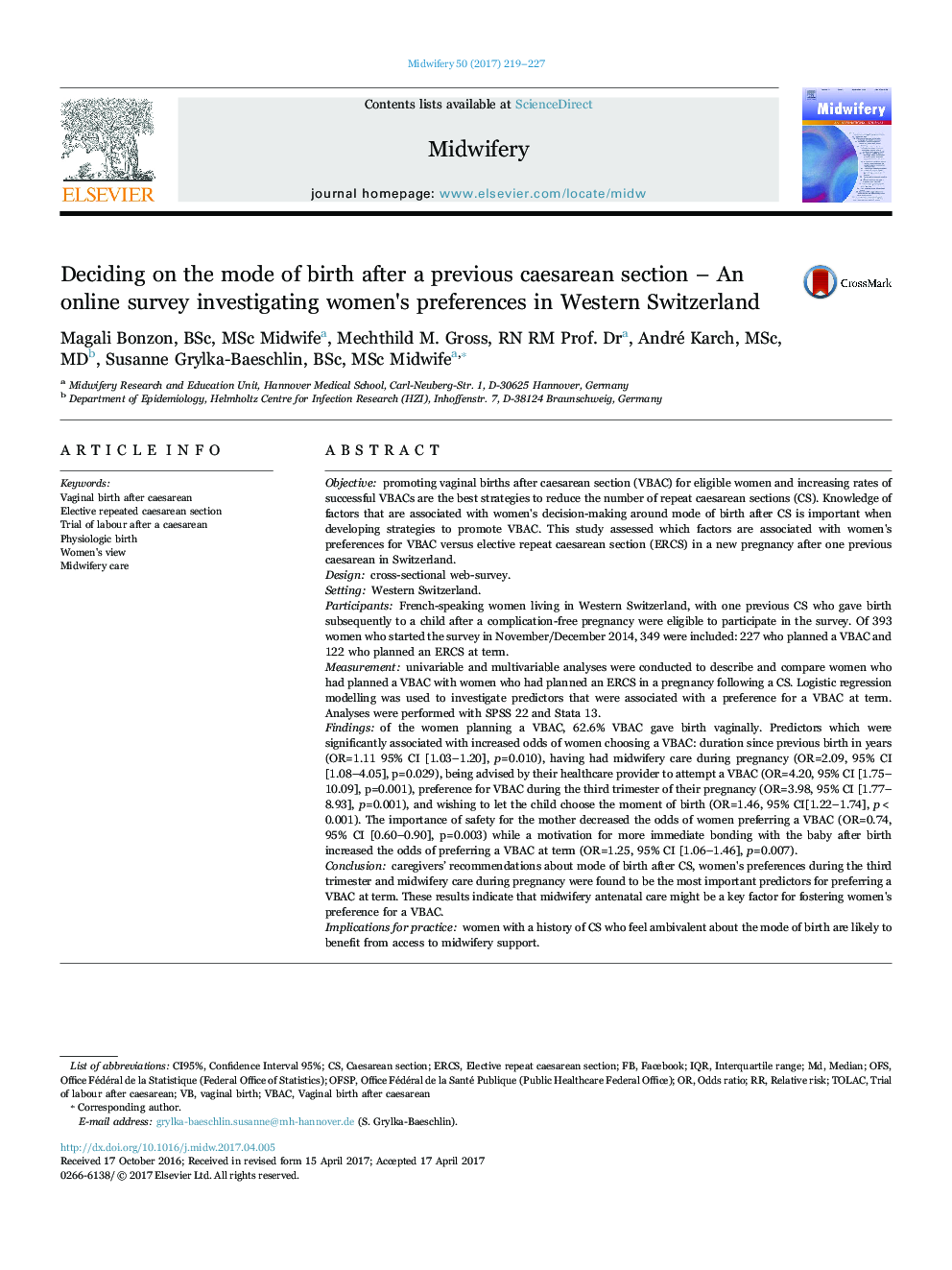| کد مقاله | کد نشریه | سال انتشار | مقاله انگلیسی | نسخه تمام متن |
|---|---|---|---|---|
| 5122372 | 1487134 | 2017 | 9 صفحه PDF | دانلود رایگان |

- Women's antenatal contacts with midwives increased the odds of a vaginal birth.
- Counselling for a vaginal birth increased the likelihood for choosing it.
- Women's perception of safety decreased the odds of preferring a vaginal birth.
- Access to midwifery-led care supported the decrease of repeat caesarean section.
Objectivepromoting vaginal births after caesarean section (VBAC) for eligible women and increasing rates of successful VBACs are the best strategies to reduce the number of repeat caesarean sections (CS). Knowledge of factors that are associated with women's decision-making around mode of birth after CS is important when developing strategies to promote VBAC. This study assessed which factors are associated with women's preferences for VBAC versus elective repeat caesarean section (ERCS) in a new pregnancy after one previous caesarean in Switzerland.Designcross-sectional web-survey.SettingWestern Switzerland.ParticipantsFrench-speaking women living in Western Switzerland, with one previous CS who gave birth subsequently to a child after a complication-free pregnancy were eligible to participate in the survey. Of 393 women who started the survey in November/December 2014, 349 were included: 227 who planned a VBAC and 122 who planned an ERCS at term.Measurementunivariable and multivariable analyses were conducted to describe and compare women who had planned a VBAC with women who had planned an ERCS in a pregnancy following a CS. Logistic regression modelling was used to investigate predictors that were associated with a preference for a VBAC at term. Analyses were performed with SPSS 22 and Stata 13.Findingsof the women planning a VBAC, 62.6% VBAC gave birth vaginally. Predictors which were significantly associated with increased odds of women choosing a VBAC: duration since previous birth in years (OR=1.11 95% CI [1.03-1.20], p=0.010), having had midwifery care during pregnancy (OR=2.09, 95% CI [1.08-4.05], p=0.029), being advised by their healthcare provider to attempt a VBAC (OR=4.20, 95% CI [1.75-10.09], p=0.001), preference for VBAC during the third trimester of their pregnancy (OR=3.98, 95% CI [1.77-8.93], p=0.001), and wishing to let the child choose the moment of birth (OR=1.46, 95% CI[1.22-1.74], p<0.001). The importance of safety for the mother decreased the odds of women preferring a VBAC (OR=0.74, 95% CI [0.60-0.90], p=0.003) while a motivation for more immediate bonding with the baby after birth increased the odds of preferring a VBAC at term (OR=1.25, 95% CI [1.06-1.46], p=0.007).Conclusioncaregivers' recommendations about mode of birth after CS, women's preferences during the third trimester and midwifery care during pregnancy were found to be the most important predictors for preferring a VBAC at term. These results indicate that midwifery antenatal care might be a key factor for fostering women's preference for a VBAC.Implications for practicewomen with a history of CS who feel ambivalent about the mode of birth are likely to benefit from access to midwifery support.
Journal: Midwifery - Volume 50, July 2017, Pages 219-227